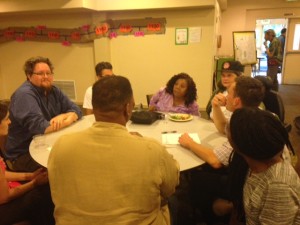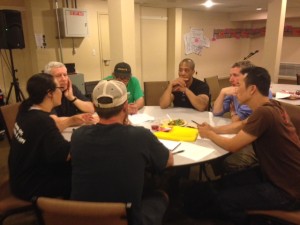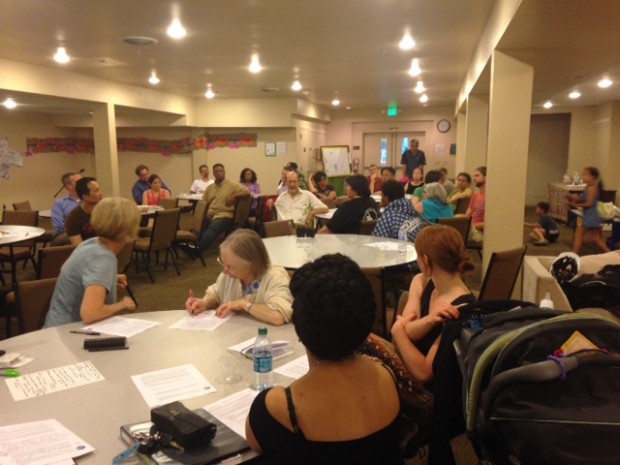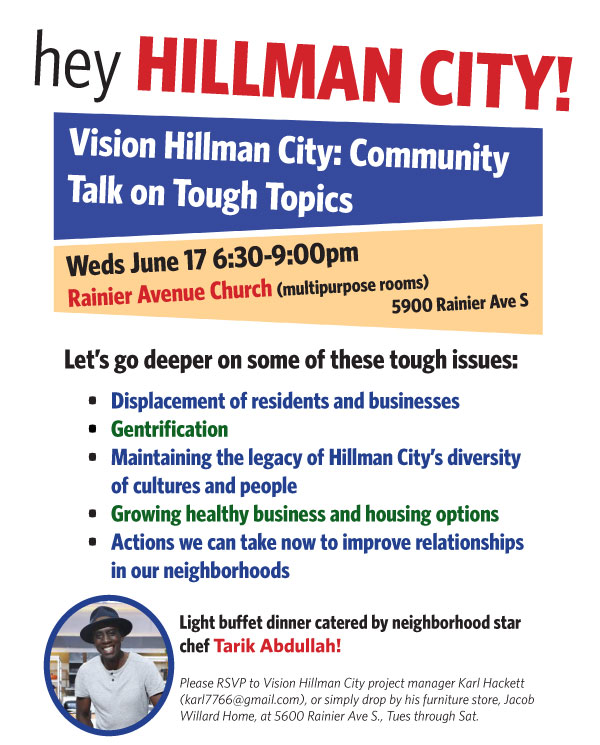JUN 17: Community Conversation at Rainier Ave Church

- Vision Hillman City Home
- Upcoming Events
- Community Conversations: Apr 23rd, Jun 17th, July 16th, Aug 20th
Vision Hillman City held its second community conversation on June 17, 2015 in the multi-purpose event space at Rainier Ave Church. Over fifty people participated, including business owners, residents, community organizers, and kids. A dinner buffet was provided by neighborhood gourmet chef, Tarik Abdullah.
This short video will give a great sense of the June 17th community conversation at Rainier Ave Church. [Video credit: Rodney Herold]
EVENT NOTES – June 17, 2015 – Rainier Ave Church
[available as a PDF: Vision Hillman City – Jun 17 Community Talk – Notes]From the kids’ worksheets: What do you like about your neighborhood?
I like how everything is within walking distance. I also like how lots of people — different people — live on each street. —Jack
I like RAC — which stands for Rainier Avenue Church. I also like the bookworm exchange store. That is what I like about my neighborhood. — Marigold
(Cool drawings.)
What changes have you seen in the neighborhood?
- More families walking around the neighborhood and businesses
- Lots of new businesses
- Raising rents, people being moved around
- A lot of people knowing about Hillman City
- City is paying more attention to Hillman City
- Fewer crack houses
- SDOT attention on Rainier Ave S (Road Diet)
- Hillman City is becoming more of a destination
- Businesses relocating from Columbia City to Hillman City
- Elementary schools that used to be majority black becoming whiter
- New businesses providing more resident services
- Decrease in crime
- More vulnerable residents feeling more tense/nervous about being pushed out of the neighborhood.
ONE-ON-ONE INTERVIEWS WITH EACH OTHER
What was it like growing up in the neighborhood you lived in? If families moved in while you lived there, how did that feel? If you moved into a new neighborhood, how did that feel?
- Ohio — 2nd People of Color (POC) family, only black family in the neighborhood. Dad was a pastor. Moved to Seattle at 15 years old. “Not black enough.”
- Durham, NC — Parents wanted him to grow up in a diverse neighborhood
- “Scary” — 7 years in Hillman City, years in CD. People would walk up to the house unsolicited, offering to buy it. One old lady resisted, but when she died, her kids sold the house.
- San Luis Obispo — Like “Mayberry”. Nobody moved in or out. Married into Seattle — suburbs, 2 years ago. Daughter inspired move to the city for diversity — personal value, faith value.
- Pritchard Beach neighborhood — Lived there since 1990’s. Older generation has left. Incompetent younger generations … lots of foreclosures. Moved business, knowing change was coming.
- Hillman City — Since 1992. 42nd & Findlay. Friendly neighbors. Some crack houses.
- None of our neighborhoods changed much growing up.
- Santa Cruz — Idyllic childhood. Became a community developer in nonprofits. Finds Seattle increasingly expensive. Might have to move because of it.
- White family … in college met a lot of other, more diverse, people … didn’t know how to react
- Seattle in the 1930’s – many young Black & Japanese families
- Grew up in the 17th story of a New York apartment building; knows change and is okay with change; feels like there is not enough variety of businesses
- Grew up in Chula Vista, used to play in the streets; neighborhood felt very cohesive
- Was a refugee and has always felt like a newcomer (Beacon Hill/Rainier Beach) until they found the right fit (neighbors, rent, etc); Remembers lots of kids getting together to play; very intense
- Grew up in Carlsbad – very suburban; has nostalgia for what he used to have; going out to play with neighbors; had informal meet ups w/neighbor kids; loves cities, walkers, transit, diversity; there is a ton of development in Carlsbad now and it no longer feels like home; now it seems elitist, like one high-end strip mall
- From Puyallup; wants to know what she can do to support the community
- Grew up in Queens, NY; very diverse; blacks on one side and white on the other side, but no tension
- Grew up in a rural village in Colorado, near the river; had to take the a 18-mile bus ride to school; community mainly white, coalminers, hippies, or drug dealers; He can recall having new neighbors but didn’t notice the changes; when they moved to Seattle, their next door neighbors were very welcoming and they got to know them very quickly; their neighborhood is very diverse and friendly; seems like their Jewish neighbors stay more to themselves
- Grew up in suburban neighborhood in North Carolina; there were no other Asians; is a third-generation Chinese-American and when she moved to the Bay Area, was blown away by how many Asian people live there. She has lived here for 10-11 years
- From a suburb of San Diego (Encinitas). Grew up in a middle class family, not much diversity by race or class; Attended UC Berkeley, then moved to Central District in Seattle in 2004; it was a very different place from where they grew up
- Grew up in Africa, attended a French-speaking school; was the only white kid and was picked on because of it; still recognizes their white privilege; then moved to the bible belt; felt very different
- Grew up in Bend, Oregon in a cul de sac. It was a small population; fairly isolated; little contact or change
How is diversity in your neighborhood or work important to you personally? What is challenging about it?
- Moved to Seattle to go to college at SPU, then started attending Rainier Avenue Church, which opened her world up to diversity
- More Asian families 20 years ago, and wealthier white families with kids; challenged by the “noise”
- Always identified as ‘son’ of Seattle – diversity and community values; likes being involved in community legacy of family
- Sons came as refugees – they attend Franklin; challenging to buy a home
- Looking for a community that’s more open & diverse than West Seattle; appreciates different ideas, lifestyles; actually getting to know neighbors has been challenging
- Appreciates racial and economic diversity; being in a developing area where options are catching up
- I want to know perspectives of people different than me; diversity is one of the benefits of living in a city; it’s a shame to become homogenous; Crises require everyone’s input; it is challenging to meet people across differences
- It is very important to my work. I am a professor of Intercultural Studies as SPU. In the cross-cultural urban studies class, send students out of Queen Anne to experience diversity – kids realizing that ‘not everyone is like you’. Wants kids to know what the real world is like but it is hard to find a not all-white pre-school here.
- It is really important to me and why I live in South Seattle, not West Seattle; feels like real life vs. living in sheltered bustle; too homogenous is boring; I need the different perspectives that only diversity of people can bring
- Lives in Columbia City; she hears they have less crime and it is safer; feels the community should be educated about better opportunities
- Less black homeowners in Seattle than on the east coast
- Highly values diversity; appreciate the difference all around him – lesbian, bi-racial, Ethiopian, guy w/pigeon as his neighbors; values diversity over the fear of crime that is often associated with racially-diverse neighborhoods; challenged because it seems to be eroding
- Values the effort that you have to put in to nurture relationships from people who are different than him; It’s that extra effort it takes to engage that leads directly to stronger community bond
- Diversity of family — wife Asian, 2 Asian kids, 1 mixed. Recent housing insecurity for family. Race .. so personal.
- Adoption of black daughter brought issues up.
- That’s why God made people different. Enjoys learning. Fear of other people is part of it. Scared of black people. Not scared of white people.
- People stay with their own people .. integrating takes work.
- Knows working class and rich folks; beer has been a cultural bridge. “We want to be a neighborhood brewery.” An aspect of beer culture is that it keeps people together.
Fun; part of our family so very important; makes me a more human person. - Challenges: We get into our own way of thinking and can’t see other perspectives. History of white supremacy makes trust difficult.
- Neighbors are diverse, but there’s not much communication between ethnic groups
Not knowing how to react
SMALL TABLE DISCUSSIONS
Report Back on Views of Gentrification and Displacement
- we love diversity
- we want to be a place where everyone can be themselves
- we’re all just Americans
- No, we’re a more diverse immigrant-heavy neighborhood
- Building owners, residents, and business owners all have different agendas and interests
- we need to ensure people have financial literacy
- we have too many absentee landlords; we want more transparency
- we need to encourage people to see the businesses and people already here that add a lot .. and that/whom we overlook because of privilege
- improvements – cleaner, nicer sidewalks come with gentrification … double-edged sword
- quality of new construction — it’s shoddy, made so quickly, falls apart
- we can make/take opportunities to get involved in what new development will be like
- people do speak out, turn up at hearings, etc. … but the City does what it wants anyway
- local orgs doing development: SEED, Urban Impact
there are several nonprofits around that can help neighbor-driven development initiatives — Mercy Housing, Bellwether, Capitol Hill Housing … these groups are all doing development in Rainier Valley - transit-oriented development: some of it HAS to be low-income housing (this mandate isn’t being tapped/explored yet); Puget Sound Sage is working on this issue.
why is new development so hum-drum? - why are construction crews all white here in Rainier Valley? Never see minorities
- In Hillman City – several of ways of ethnic groups living here — Italian, Japanese, African American, East African …
- African Americans have been living here a long while, not just recently … back in the 40’s too. Foreclosure crisis heavily impacted this neighborhood. Minority populations were given the highest interest loans. Redlining, covenants — these were never legal, but prevalent. Ended with 1961 Housing Act (?)
- being in separated communities, we don’t get to know each other enough; as a result, we’re ignorant about each other
- African Americans keep getting booted .. at work, where they live …
- people come in with a lot of $$ .. the disparity creates a lot of tension
- reading about equitable development — learning that businesses that serve the NEEDS for a community help a neighborhood thrive
- ownership … more control .. key to helping people stay in their business locations
- what makes for a good business mix? what’ really needed in the community?
- People moving in seem to be more insular; equates that to being more affluent; less interested in integrating w/neighbors
- Losing ethnic & income diversity
- Experience neighborliness in their neighborhood
- East African business concerned about rising rents
- Property owners have a lot to do w/commercial rents; who are they in H.C.?
- Zoning – Urban Planning; what’s the zoning on Rainier Ave S?
- Density helps local businesses
- Small business owners need to also have some savvy to compete in a booming economy
- Rent-control is a non-starter in WA State, would need state legislation; could City Council be progressive enough to sue state to change that?
- Splitting lots – new houses
- Moved to neighborhood for diversity, worry about losing that; child goes to Graham Hill; values walking down Rainier to take child to school and meeting neighbors/fellow parents from different backgrounds; appreciates affordability, walkability and diversity (neighborliness)
- Rainier & MLK used to be freeways, pedestrian friendly makes for community move kids are driven to school ~ 90%; walkability needs to be ‘grown’ back!; when neighbors walk their neighborhoods they can see what their neighborhood needs
SDOT is car-oriented over people-oriented - Are there examples of gentrification that does not lead to displacement? There are no example where significant economic changes done lead to a lot of displacement; some solutions revolve around housing; non-profit affordable housing; subsidized housing; rent control; but huge corporations & huge money are hard to stop.
Community Benefits Agreement (CBA) ~ this is what happened with Goodwill development on Dearborn; leverage City Council rep & developers to have to provide mitigations to communities & subsidized housing, but some developer agreements expire after 5-7 years - Really high turnover of housing residents; people are buying homes and then renting to pay mortgages
- Developers buy small houses, often from folks of color, and build large, expensive apartments
- Housing prices will fluctuate based on demand and those who can afford it, buy it
- Those who are known as ‘gentrifiers’ could be called ‘investors’
- Services follow wealth – sidewalks followed condos
- How do we spur ourselves on toward change? Guile is one way. Perhaps city housing policies are the place to make efforts.
- Everyone-including business owners – pays the price when housing prices rise
- Put together groups of buyers interested in the betterment of the community with potential sellers
- Community land trust (like Homestead Community Land Trust): people own the houses, but not the land, but can still make a modest profit
Knowing that gentrification and the displacement of residents, businesses and community institutions present big challenges, what is one piece of the puzzle that you can contribute to the solution? It can be at any level, personal or neighborhood … Who might you work with?
- Visiting old & new businesses that are in the neighborhood (spending $$ here)
- Working to build a mother-in-law unit to rent out at below market rate
- Educating ourselves on what is possible to support more subsidized or affordable houses. What is the power of residents and how do we exert that power
- Communicate more between businesses & community — let people know what services are available in the neighborhood to serve them (and if it offers services both at market rate & below, according to need)
- Shared ownership/investing models — learn more about them, how to utilize those strategies, bring in community experts to do workshops
- The cycle of neighborhoods … young couples move in, age. Cycle repeats. Look at resources to support seniors in the community.
- Race aspect of gentrification — making space for that conversation
- Policy conversations need to be in laymen’s terms — bringing everyone along.
- People’s feelings need to be rolled in. Any policy convo needs to be able to do that.
- Bringing people together to do work projects (e.g. Bridge to Beach, July 5th fireworks clean-up at Brighton Park, work in Brandon St Orchard, Hillman City P-Patch)
- Intoxication (e.g. Spinnaker Bay) – social lubricant. Social gatherings at Spinnaker Bay. Business is rooted in passion of wanting to be here. Collaborations with folks working together with the business community to build Hillman City.
- Neighbors are friendly … but back in the day & the younger generation losing their homes. Pre-lending. Sad to see.
- Want to thank everyone for support that has been given.
- Swapping language skills — building trust, cookouts, this summer.
- Shoutout for Karl Hackett: He’s been talking to people about investment, property ownership in Hillman City commercial corridor. Keeping it local, with neighborhood-love values.
- Reference: Dudley Street housing land trust in Philly — see the film about it. Better yet, let’s see it as a group! [Holding Ground]
- Divide into committees — assess gentrification as it applies to 1) commercial and 2) residential concerns. “Free of emotion” … recognizing that our collective goals may be at odds with each other. Making room for that. Establish work products that are shared with the community.
- Challenge to thinking about development/economic/zoning policy in an analytical conversation: It leaves people out. It shuts people out.
- Information has to be accessible to everyone
- Promote local ownership. People of conscience who also have means.
- Very hard … here with questions, not answers yet. There are no obvious villains in gentrification/displacement issue
- Support local businesses.
- Building granny unit with the idea of renting below market value; creating opportunity for disadvantaged resident. Pessimistic re impacting change through policy.
- “We are here to support the community” – provide good things locally; provide partnership between residents/businesses to have neighborhood vitality.
- Swap language skills with a neighbor. One-on-one relationships to build trust. Serve goat (culturally relevant food) at cook-outs
- Working on diversity, equitability
- Build trust; create a book with each person’s skill set listed in it
- Newcomers all the time; it’s all about intention as neighbors; celebrations; festivals; cultivate regular community events; community-building and cleaning; class & money changes everything; continuing ways to invest in local businesses and community
- Can’t keep up yard anymore and wants to move where daughter in Issaquah; more expensive; would like to keep the house in the family
- Seeing rules change (class a part); regularly attending community events that bring people together to decide what is important for heritage; built own heritage; S.A.F.E. – anti-displacement; personal community involvement; placing a high value on knowing your neighbors
- Works on p-patch program, Brandon St Orchard, and other community projects
- Intentionally walking & talking with neighbors who are no like me; shopping locally
- Real neighbor connections; shared community space
- Race is very personal; has seen changes between the people here 20+ years and people who have showed up in last five years.
- That’s why I am here; can do local things, attend local events, using transit, supporting local businesses
- Community investing; hyperlocal investing; things like better signage; local ownership of buildings
- Working with the youth; positive economic development
- Reach out to community through business discount programs
- Get to know your newer neighbors, while maintaining relationships with your long-time neighbors. Write letters to decision makers to create more affordable housing options; encouraging smaller businesses to work together more so that one store isn’t selling the exact same thing as another store
MISC RESOURCES NAMED, NOTED
Fruitvale Neighborhood: positive economic development example
Hillman City Business Association
Holding Ground documentary about Dudley Street Neighborhood project in Boston neighborhood.
Homestead Community Land Trust
Puget Sound Sage – building communities where all families thrive.
Rainier Valley Community Development Fund (RVCDF) – Natalie Hester. They offer small business development training
Standing Against Foreclosure and Eviction (S.A.F.E.)
SouthEast Effective Development (SEED)
EVENT PROMOTIONAL FLIER



